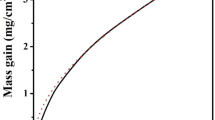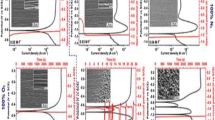Abstract
The anodic oxide on titanium can be thickened by anodization, with the consequent corrosion properties of this oxide depending on many variables, including the electrochemical perturbation, the final growth potential, and the nature of the electrolyte. During this anodization, an oxygen evolution reaction (OER) is frequently observed, contributing to reduction of the current efficiency of anodic oxide formation. Based on these factors, evaluation was made of the effect of the electrolyte on oxide film formation and inhibition of the OER during Ti anodization in aqueous H3PO4 and H2SO4 solutions with pH 1. The oxide films were grown by voltammetry and were characterized by electrochemical impedance spectroscopy (EIS) and the Mott-Schottky method. Interpretation of the electrochemical results indicated that inhibition of the OER was due to the adsorption of PO43− ions and their incorporation during growth of the oxide film. The EIS results showed that the oxide films formed in H3PO4 solution were also the most corrosion resistant.




Similar content being viewed by others
References
Schultze JW, Lohrengel MM (2000) Stability, reactivity and breakdown of passive films. Problems of recent and future research. Electrochim Acta 45:2499–2513
Blackwood DJ, Peter LM, Williams DE (1988) Stability and open circuit breakdown of the passive oxide film on titanium. Electrochim Acta 33:1143–1149
Sul Y-T, Johansson CB, Jeong Y, Albrektsson T (2001) The electrochemical oxide growth behaviour on titanium in acid and alkaline electrolytes. Med Eng Phys 23(5):329–346
Roy P, Berger S, Schmuki P (2011) TiO2 nanotubes: synthesis and applications. Angew Chem Int Ed 50(13):2904–2939
Nguyen T-DT, Park I-S, Lee M-H, Bae T-S (2013) Enhanced biocompatibility of a pre-calcified nanotubular TiO2 layer on Ti–6Al–7Nb alloy. Surf Coat Technol 236:127–134
Mohsen Q, Fadl-Allah SA (2011) Improvement in corrosion resistance of commercial pure titanium for the enhancement of its biocompatibility. Mater Corros 62:310–319
Mohammed MT, Khan ZA, Siddiquee AN (2014) Surface modifications of titanium materials for developing corrosion behavior in human body environment: a review. Procedia Mater Sci 6:1610–1618
Shahali H, Jaggessar A, Yarlagadda PK (2017) Recent advances in manufacturing and surface modification of titanium orthopaedic applications. Procedia Engineering 174:1067–1076
Ibrahim MZ, Sarhan AAD, Yusuf F, Hamdi M (2017) Biomedical materials and techniques to improve the tribological, mechanical and biomedical properties of orthopedic implants – a review article. J Alloys Compd 714:636–667
Ohtsu N, Bai M, Yamaguchi K (2019) Anomalous anodic layer growth on titanium occurring in electrolyte comprising nitrate and water. Surf Coat Technol 374:65–71
Wu S, Wang S, Liu W et al (2019) Microstructure and properties of TiO2 nanotube coatings on bone plate surface fabrication by anodic oxidation. Surf Coat Technol 374:362–373
Liu ZJ, Zhong X, Walton J, Thompson GE (2016) Anodic film growth of titanium oxide using the 3-electrode electrochemical technique: effects of oxygen evolution and morphological characterizations. J Electrochem Soc 163:E75–E82
Ferreira EA, Rocha-Filho RC, Biaggio SR, Bocchi N (2010) Corrosion resistance of the Ti–50Zr at.% alloy after anodization in different acidic electrolytes. Corros Sci 52:4058–4063
Guedes LFN, Dalboni Garcia MT, Cunha JN et al (2016) Ellipsometric and mechanical characterization of nanostructured anodic oxide film formed on Ti-6Al-7Nb alloy. J Solid State Electrochem 20:2517–2523
Laveissière M, Cerda H, Roche J et al (2019) In-depth study of the influence of electrolyte composition on coatings prepared by plasma electrolytic oxidation of TA6V alloy. Surf Coat Technol 361:50–62
Tributsch H (2006) Electrochemistry at semiconductor and oxidized metal electrodes. Von S. R. Morrison. Plenum Press, New York 1980. Angew Chem 94:85–86
Boddy PJ (1968) Oxygen evolution on semiconducting TiO2. J Electrochem Soc 115:199–203
Ge H, Tian H, Zhou Y, Wu S, Liu D, Fu X, Song XM, Shi X, Wang X, Li N (2014) Influence of surface states on the evaluation of the flat band potential of TiO2. ACS Appl Mater Interfaces 6(4):2401–2406
Ferreira EA, Oliveira NTC, Biaggio SR et al (2006) XPS characterization of anodic oxides grown on biocompatible Ti–50Zr alloy in different acid electrolytes. Surf Interface Anal 38:417–421
Delplancke J-L, Winand R (1988) Galvanostatic anodization of titanium - I. structures and compositions of the anodic films. Electrochim Acta 33:1539–1549
Ferdjani S, David D, Beranger G (1993) Anodic oxidation of titanium in phosphoric acid baths: phosphorus incorporation into the oxide. J Alloys Compd 200:191–194
Khalil N, Leach JSL (1996) Anodic oxidation of zirconium: effect of fluoride contamination on oxide structure and transport processes. J Appl Electrochem 26:231–231
Randall JJ, Bernard WJ, Wilkinson RR (1965) A radiotracer study of the composition and properties of anodic oxide films on tantalum and niobium. Electrochim Acta 10:183–201
Rogers GT, Draper PHG, Wood SS (1968) Anion impurities in anodic oxide films on zirconium. Electrochim Acta 13:251–261
Archibald LC, Leach JSL (1977) The anodic oxidation of zirconium - II. Growth and morphology of anodic ZrO2 films. Electrochim Acta 22:21–25
Våland T, Nilsson G (1977) The influence of F− ions on the electrochemical reactions on oxide-covered A1. Corros Sci 17:449–459
Wood GC (1996) A model for the incorporation of electrolyte species into anodic alumina. J Electrochem Soc 143:74
Mogoda AS, El-Taib Heakal F, Ghoneim AA (1992) Formation and dissolution behaviour of ZrO2 film in H3PO4 acid solutions. Thin Solid Films 219:146–152
Sloppy JD, Podraza NJ, Dickey EC, Macdonald DD (2010) Complex dielectric functions of anodic bi-layer tantalum oxide. Electrochim Acta 55:8751–8757
Vanhumbeeck J-F, Proost J (2009) Current understanding of Ti anodisation: functional, morphological, chemical and mechanical aspects. Corros Rev 27:117–204
Narayanan R, Seshadri SK (2008) Point defect model and corrosion of anodic oxide coatings on Ti–6Al–4V. Corros Sci 50:1521–1529
Narayanan R, Seshadri SK (2007) Phosphoric acid anodization of Ti–6Al–4V - structural and corrosion aspects. Corros Sci 49:542–558
Kong D-S, Wu J-X (2008) An electrochemical study on the anodic oxygen evolution on oxide film covered titanium. J Electrochem Soc 155:C32
Kong DS (2008) The influence of fluoride on the physicochemical properties of anodic oxide films formed on titanium surfaces. Langmuir 24(10):5324–5331
Gomez Sanchez A, Schreiner W, Duffó G, Ceré S (2013) Surface modification of titanium by anodic oxidation in phosphoric acid at low potentials. Part 1. Structure, electronic properties and thickness of the anodic films. Surf Interface Anal 45:1037–1046
Connor PA, McQuillan AJ (1999) Phosphate adsorption onto TiO2 from aqueous solutions: an in situ internal reflection infrared spectroscopic study. Langmuir 15:2916–2921
Song G (2005) Transpassivation of Fe–Cr–Ni stainless steels. Corros Sci 47:1953–1987
Olefjord I (1985) Surface composition of stainless steels during anodic dissolution and passivation studied by ESCA. J Electrochem Soc 132:2854
Sato N (1990) An overview on the passivity of metals. Corros Sci 31:1–19
Sun EX, Nowak WB (2001) Electrochemical characteristics of Ti–6Al–4V alloy in 0.2 N NaCl solution. Corros Sci 43:1801–1816
Chao CY (1981) A point defect model for anodic passive films. J Electrochem Soc 128:1187
Ohtsuka T, Nomura N (1997) The dependence of the optical property of Ti anodic oxide film on its growth rate by ellipsometry. Corros Sci 39:1253–1263
Krasicka-Cydzik E (2004) Gel-like layer development during formation of thin anodic films on titanium in phosphoric acid solutions. Corros Sci 46:2487–2502
Sul Y (2003) The significance of the surface properties of oxidized titanium to the bone response: special emphasis on potential biochemical bonding of oxidized titanium implant. Biomaterials 24(22):3893–3907
Jaeggi C, Kern P, Michler J, Patscheider J, Tharian J, Munnik F (2006) Film formation and characterization of anodic oxides on titanium for biomedical applications. Surf Interface Anal 38:182–185
Macdonald JR (1987) Impedance spectroscopy: emphasizing solid materials and systems. Wiley, New York
Orazem ME, Tribollet B (2008) Electrochemical impedance spectroscopy. Wiley, Hoboken, N.J
Ellerbrock D, Macdonald DD (2019) Passivity of titanium, part 1: film growth model diagnostics. J Solid State Electrochem 18:1485–1493
Roh B, Macdonald DD (2019) Passivity of titanium: part II, the defect structure of the anodic oxide film. J Solid State Electrochem 23:1967–1979
Roh B, Macdonald DD (2019) Passivity of titanium, part IV: reversible oxygen vacancy generation/annihilation. J Solid State Electrochem 23:2863–2879
Roh B, Macdonald DD (2007) Effect of oxygen vacancies in anodic titanium oxide films on the kinetics of the oxygen electrode reaction. Russ J Electrochem 43:125–135
Hernández-López JM, Conde A, de Damborenea J, Arenas MA (2015) Correlation of the nanostructure of the anodic layers fabricated on Ti13Nb13Zr with the electrochemical impedance response. Corros Sci 94:61–69
Marsh J, Gorse D (1998) A photoelectrochemical and ac impedance study of anodic titanium oxide films. Electrochim Acta 43:659–670
Roh B, Macdonald DD (2019) The passivity of titanium - part III: characterization of the anodic oxide film. J Solid State Electrochem 23:2001–2008
El Kader JMA, El Wahab FMA, El Shayed HA, Khedr MGA (1981) Oxide film thickening on titanium in aqueous solutions in relation to anion type and concentration. Br Corros J 16:111
Di Quarto F, Di Paola A, Sunseri C (1981) Semiconducting properties of anodic WO3 amorphous films. Electrochim Acta 26:1177–1184
Ohtsuka T, Otsuki T (1998) The influence of the growth rate on the semiconductive properties of titanium anodic oxide films. Corros Sci 40:951–958
Funding
The authors would like to thank the Brazilian funding agency CAPES (Coordenação de Aperfeiçoamento de Pessoal de Nível Superior) for the financial support.
Author information
Authors and Affiliations
Corresponding author
Additional information
Publisher’s note
Springer Nature remains neutral with regard to jurisdictional claims in published maps and institutional affiliations.
Rights and permissions
About this article
Cite this article
Saldanha, R.L., Gomes, B.C., da Rocha Torres, G. et al. Inhibition of the oxygen evolution reaction during titanium passivation in aqueous phosphoric acid solution. J Solid State Electrochem 24, 1991–1998 (2020). https://doi.org/10.1007/s10008-020-04497-2
Received:
Revised:
Accepted:
Published:
Issue Date:
DOI: https://doi.org/10.1007/s10008-020-04497-2




